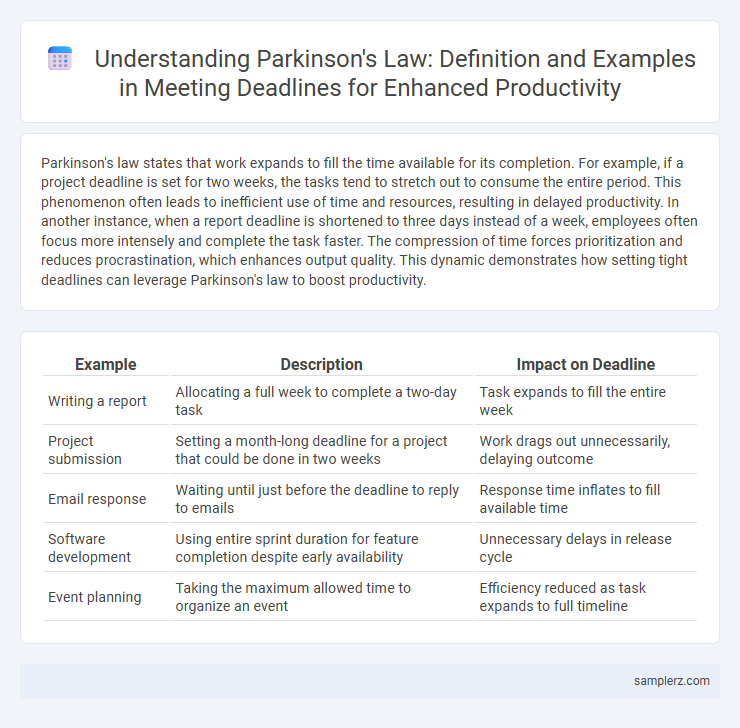Parkinson's law states that work expands to fill the time available for its completion. For example, if a project deadline is set for two weeks, the tasks tend to stretch out to consume the entire period. This phenomenon often leads to inefficient use of time and resources, resulting in delayed productivity. In another instance, when a report deadline is shortened to three days instead of a week, employees often focus more intensely and complete the task faster. The compression of time forces prioritization and reduces procrastination, which enhances output quality. This dynamic demonstrates how setting tight deadlines can leverage Parkinson's law to boost productivity.
Table of Comparison
| Example | Description | Impact on Deadline |
|---|---|---|
| Writing a report | Allocating a full week to complete a two-day task | Task expands to fill the entire week |
| Project submission | Setting a month-long deadline for a project that could be done in two weeks | Work drags out unnecessarily, delaying outcome |
| Email response | Waiting until just before the deadline to reply to emails | Response time inflates to fill available time |
| Software development | Using entire sprint duration for feature completion despite early availability | Unnecessary delays in release cycle |
| Event planning | Taking the maximum allowed time to organize an event | Efficiency reduced as task expands to full timeline |
Understanding Parkinson’s Law in the Context of Deadlines
Parkinson's Law states that work expands to fill the time available for its completion, causing deadlines to often feel more urgent as they approach. In productivity, this means tasks are likely to take longer when given extended deadlines, reducing efficiency and focus. Recognizing this phenomenon encourages setting shorter, well-defined deadlines to boost concentration and accelerate task completion.
Real-World Examples of Parkinson’s Law Impacting Project Timelines
Parkinson's Law illustrates that work expands to fill the time allocated, as seen in software development projects where deadlines are extended without increasing output. For example, a study by the Standish Group revealed that project tasks often take longer when deadlines are flexible, leading to scope creep and delayed delivery. Construction projects also exhibit this effect, with firms frequently using the entire allotted timeline despite the possibility of earlier completion.
How School Assignments Illustrate Parkinson’s Law with Deadlines
School assignments often exemplify Parkinson's Law, as students tend to expand their work to fill the available time before deadlines, leading to extended periods of procrastination and last-minute rushes. This tendency causes tasks to consume more time than necessary, reducing overall productivity and increasing stress levels. Efficient time management strategies can counteract this effect by setting shorter, self-imposed deadlines to enhance focus and task completion speed.
Workplace Reports: When Deadlines Stretch and Tasks Expand
Parkinson's Law illustrates how workplace reports often consume the entire allocated time, with tasks expanding to fill extended deadlines. Employees tend to prolong report preparation when deadlines are flexible, reducing overall productivity and delaying decision-making processes. Setting tighter, well-defined deadlines can enhance efficiency by preventing unnecessary task expansion in report generation.
Freelancers and the Tendency to Match Work to Time Allotted
Freelancers often experience Parkinson's Law, where tasks expand to fill the time available, leading to extended deadlines and reduced productivity. For instance, a project estimated to take five days may stretch unnecessarily, as freelancers subconsciously match their effort to the time allotted rather than the actual task requirements. This tendency highlights the importance of setting tighter deadlines and clear milestones to maintain focus and efficiency in freelance work.
Group Projects: Parkinson’s Law in Collaborative Deadline Settings
Parkinson's Law states that work expands to fill the time available, often impacting group projects where deadlines are flexible. In collaborative deadline settings, teams may procrastinate or overextend tasks, causing inefficiency and rushed last-minute efforts. Establishing strict deadlines and breaking work into smaller, time-bound segments enhances focus and productivity, counteracting the tendency of Parkinson's Law to dilate project timelines.
Creative Professionals: Deadline Pressure and Efficiency Patterns
Creative professionals often experience Parkinson's law, where tasks expand to fill the available deadline, leading to decreased efficiency in longer project timelines. Tight deadlines force focused attention and streamlined workflows, enhancing productivity and fostering innovative solutions. Understanding this pattern helps creatives structure deadlines effectively to optimize output and maintain high-quality work.
Technology Teams: Software Development and Flexible Deadlines
Technology teams in software development often experience Parkinson's Law, where tasks expand to fill flexible deadlines, causing extended project timelines and diluted productivity. When deadlines are ambiguous or overly generous, developers may procrastinate or over-engineer solutions, hindering timely delivery and efficient resource allocation. Implementing firm, well-defined deadlines enhances focus, accelerates progress, and maximizes team productivity by preventing unnecessary expansion of work scope.
Event Planning: The Effect of Expanding Tasks to Fit Deadlines
In event planning, Parkinson's law is evident when the scope of tasks expands to fill the available deadline, causing prolonged preparation time without increased efficiency. For example, given a month to organize a conference, planners may extend research, vendor negotiations, and marketing activities to occupy the entire period rather than optimizing their workflow. This tendency leads to delayed decision-making and resource allocation, undermining productivity and potentially increasing costs.
Personal Productivity: Self-Imposed Deadlines and Work Expansion
Parkinson's Law states that work expands to fill the time available, often causing tasks to take longer when deadlines are loose. Setting self-imposed deadlines can boost personal productivity by creating a sense of urgency and limiting unnecessary task expansion. This approach helps maintain focus and achieve goals more efficiently by compressing work into shorter, well-defined time frames.

example of Parkinson's law in deadline Infographic
 samplerz.com
samplerz.com